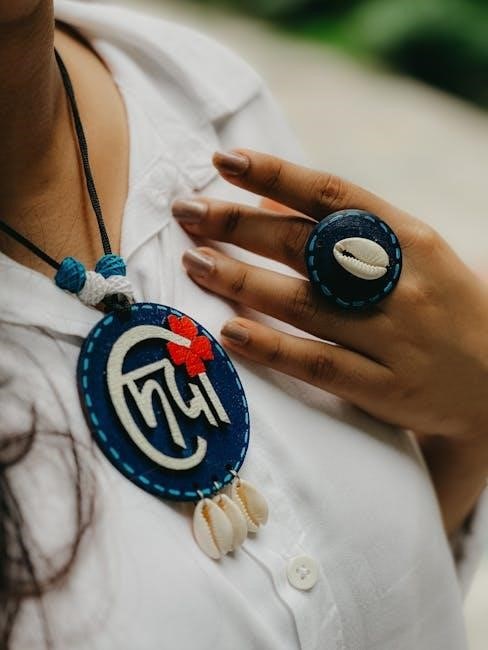Split rings are essential components in various applications, offering durability and reliability. Understanding their sizing is crucial for optimal performance in jewelry, fishing, and industrial uses. Proper sizing ensures functionality, longevity, and aesthetic appeal, making size guides and technical specifications indispensable tools for selection. This guide provides comprehensive insights into split ring sizing, materials, and applications, helping users make informed decisions. Always consider weight, load-bearing capacity, and manufacturer recommendations when choosing the right split ring size for your specific needs. Proper sizing ensures functionality, longevity, and aesthetic appeal, making size guides and technical specifications indispensable tools for selection. This guide provides comprehensive insights into split ring sizing, materials, and applications, helping users make informed decisions. Always consider weight, load-bearing capacity, and manufacturer recommendations when choosing the right split ring size for your specific needs. Proper sizing ensures functionality, longevity, and aesthetic appeal, making size guides and technical specifications indispensable tools for selection. This guide provides comprehensive insights into split ring sizing, materials, and applications, helping users make informed decisions. Always consider weight, load-bearing capacity, and manufacturer recommendations when choosing the right split ring size for your specific needs. Proper sizing ensures functionality, longevity, and aesthetic appeal, making size guides and technical specifications indispensable tools for selection. This guide provides comprehensive insights into split ring sizing, materials, and applications, helping users make informed decisions. Always consider weight, load-bearing capacity, and manufacturer recommendations when choosing the right split ring size for your specific needs.
1.1 Overview of Split Rings
Split rings are circular connectors made from two interlocking halves, designed to securely attach components in jewelry, fishing tackle, and industrial applications. Their durability and reliability make them a versatile choice. Commonly used in jewelry for attaching pendants and in fishing for lures, split rings vary in size and material. Stainless steel is a popular choice for its strength and corrosion resistance. Sizes are measured by inner diameter, wire thickness, and overall dimensions. Proper sizing ensures the ring holds securely without compromising flexibility. Choosing the right split ring size is essential for performance and longevity. Always select based on weight, load, and material requirements to ensure optimal functionality and reliability. This guide helps navigate size selection for various uses.
1.2 Applications of Split Rings
Split rings are widely used across various industries due to their versatility and strength. In jewelry making, they are ideal for attaching pendants, charms, and clasps, ensuring secure connections. For fishing tackle, split rings are essential for connecting lures, hooks, and swivels, enduring harsh conditions. Industrial applications utilize them for fastening components in machinery and equipment. Their durability and resistance to corrosion make them suitable for both freshwater and saltwater environments. Additionally, split rings are used in crafting and DIY projects for hanging ornaments or organizing cables. Their reliability and ease of use make them a preferred choice for both practical and creative purposes. Understanding their applications helps in selecting the appropriate size and material for specific needs, ensuring optimal performance and longevity.

Understanding Split Ring Sizes

Split ring sizes are critical for ensuring optimal performance and durability in various applications. Proper sizing depends on factors like weight, lure size, and material strength. Smaller rings reduce visibility but may lack strength, while larger rings offer durability but can be bulky. Standard sizes range from 1 to 12, with specific diameters and breaking strengths. Accurate measurement ensures secure connections and prevents damage. For fishing, matching ring size to lure weight is essential for reliability. In jewelry, sizing affects both aesthetics and functionality. Understanding size specifications helps users select rings that balance strength, versatility, and visual appeal, ensuring longevity and performance in their intended use.
2.1 Definitions and Terminology
Understanding split ring terminology is vital for accurate sizing. Common terms include outer diameter (O/D), inner diameter (I/D), and wire diameter. The O/D refers to the ring’s external measurement, while I/D is the internal opening. Wire diameter indicates the thickness of the metal, influencing strength and durability. Breaking strength denotes the maximum weight a ring can hold before failing. Size charts correlate these measurements with numerical sizes, often ranging from 1 to 12. Terminology like comfort fit and standard fit applies to jewelry rings, ensuring proper wearability. In fishing contexts, terms like lure weight capacity and line strength compatibility are crucial. Accurate terminology helps in selecting the right size for specific applications, ensuring reliability and performance.
2.2 Standard Size Ranges
Split rings are available in a variety of standard sizes to suit different applications. For jewelry, common sizes range from 4 to 13, with 7 being the average. Fishing split rings typically range from 1 to 12, with larger sizes accommodating heavier lures and lines. Industrial applications may use specialized sizes beyond these ranges. Size charts often include measurements in millimeters, such as 3mm to 10mm, ensuring precise fitment. Standardization allows for consistency across manufacturers, making it easier to choose the correct size. Always refer to the specific size chart provided by manufacturers to ensure compatibility with your needs. Proper sizing is essential for performance and longevity in any application.
2.3 Measurement Methods
Measuring split rings accurately is crucial for selecting the right size. Key dimensions include the inner diameter (I/D), outer diameter (O/D), wire diameter, and total thickness. Use digital calipers for precise measurements, ensuring accuracy to 0.1mm. For fishing tackle, measure the lure’s weight and size to match it with the appropriate split ring size. Refer to manufacturer-provided size charts, which often list specifications like 3mm to 10mm for inner diameters. Proper measurement ensures the split ring fits securely, balancing strength and flexibility. Always consult technical specifications or guides for precise measurements tailored to your application. Accurate sizing ensures optimal performance and durability in both jewelry and fishing contexts.

Materials and Their Impact
Stainless steel split rings are highly durable and resistant to corrosion, ideal for saltwater use. Other materials like brass or plastic offer flexibility for lighter applications. Material choice impacts strength, weight, and cost, ensuring optimal performance in specific settings. Always consider environmental factors and load requirements when selecting materials. Stainless steel split rings are highly durable and resistant to corrosion, ideal for saltwater use. Other materials like brass or plastic offer flexibility for lighter applications. Material choice impacts strength, weight, and cost, ensuring optimal performance in specific settings. Always consider environmental factors and load requirements when selecting materials. Stainless steel split rings are highly durable and resistant to corrosion, ideal for saltwater use. Other materials like brass or plastic offer flexibility for lighter applications. Material choice impacts strength, weight, and cost, ensuring optimal performance in specific settings. Always consider environmental factors and load requirements when selecting materials. Stainless steel split rings are highly durable and resistant to corrosion, ideal for saltwater use. Other materials like brass or plastic offer flexibility for lighter applications. Material choice impacts strength, weight, and cost, ensuring optimal performance in specific settings. Always consider environmental factors and load requirements when selecting materials.
3.1 Stainless Steel Rings
Stainless steel split rings are highly durable and resistant to corrosion, making them ideal for saltwater fishing and heavy-duty applications. They offer exceptional strength and longevity, ensuring reliable performance. With high load-bearing capacity, they are preferred for larger lures and harsh environments. Their resistance to rust and wear ensures they maintain functionality over time. Stainless steel rings are also easy to maintain, requiring minimal care to retain their quality. They are a popular choice among anglers and jewellers due to their versatility and durability. When selecting stainless steel split rings, consider the wire diameter and inner/outer dimensions to match your specific needs. This ensures optimal performance and longevity in various applications.
3.2 Other Materials and Their Properties
Beyond stainless steel, split rings are crafted from various materials, each with unique properties. Spring steel rings are known for their strength and ability to retain shape, making them ideal for heavy-duty applications. Titanium rings offer superior corrosion resistance and are lightweight, perfect for marine environments. Coated materials, like nickel-plated steel, provide enhanced durability and resistance to wear. Plastic or polymer rings are lightweight and suitable for lighter applications. Each material offers distinct advantages, catering to specific needs. When choosing, consider factors like weight, environment, and load requirements. The right material ensures optimal performance and longevity, whether for fishing tackle or industrial use. Proper material selection enhances functionality and reliability in diverse applications.

Choosing the Right Size
Choosing the right split ring size involves considering weight capacity, durability, and specific use cases. Measure the lure or item, consult size charts, and prioritize breaking strength for reliability. Always select the smallest suitable size to ensure optimal performance and longevity in jewelry, fishing, or industrial applications.
4.1 For Jewelry Purposes
When selecting split rings for jewelry, consider the size and fit of the piece. Use a ring size chart to determine the correct diameter. Comfort fit is essential for everyday wear. Choose durable materials like stainless steel for longevity. Measure the inner diameter and wire thickness for a secure connection. Ensure the split ring complements the jewelry’s design and weight. Proper sizing prevents discomfort and ensures the piece stays intact. Refer to international size standards for accurate measurements. Use conversion tools to match your needs. A well-fitted split ring enhances both functionality and aesthetic appeal in jewelry designs.
4.2 For Fishing Tackle
Choosing the right split ring size for fishing tackle is crucial for performance and reliability. Consider the weight and size of your lure or bait, as this determines the necessary strength and durability. Use a split ring size chart to match the ring’s inner diameter and wire thickness to your tackle’s requirements. Stainless steel split rings are ideal for heavy-duty saltwater use due to their corrosion resistance. Ensure the ring’s size is appropriate for the fish species you’re targeting to prevent breakage. Opt for the smallest possible split ring that meets your strength needs to minimize weight and maximize effectiveness. Proper sizing ensures your tackle performs optimally, increasing your chances of a successful catch. Always consult manufacturer recommendations for specific applications.

Size Charts and Conversion Tools
Size charts and conversion tools are essential for determining split ring sizes accurately. They provide standardized measurements, ensuring compatibility and performance. Downloadable guides offer detailed specs for easy reference.
5.1 International Standards
International standards for split rings ensure consistency across different regions and industries. These standards, often established by organizations like ISO, define measurements and materials for uniformity. For instance, split rings used in fishing tackle must meet specific strength and durability criteria, varying by country and application. Manufacturers worldwide adhere to these guidelines to guarantee product reliability and compatibility. By following international standards, consumers can trust the quality and performance of split rings, whether for jewelry, fishing, or industrial use. These standards also facilitate easier comparison and selection, making it simpler to choose the right split ring for any purpose. Compliance with international standards is a hallmark of premium products.
5.2 Conversion Tools and Resources
Conversion tools and resources are invaluable for determining the correct split ring size. Online size charts and conversion guides provide precise measurements, ensuring compatibility across different brands and regions. Many manufacturers offer detailed specifications, such as outer diameter, inner diameter, and wire thickness, to help users match their needs. Interactive tools allow anglers to input lure weight and size, recommending the ideal split ring for their setup. Additionally, resources like technical specifications from Leonardt Ltd and BKK provide comprehensive data for making informed decisions. These tools are especially useful for international shoppers, ensuring size consistency and optimal performance. By utilizing these resources, users can confidently select the right split ring for their application, whether for fishing tackle or jewelry. Accurate sizing ensures reliability and durability, making these tools essential for any split ring user.

Factors Influencing Size Selection
When choosing split ring sizes, consider design, weight, and manufacturer recommendations. Smaller rings offer strength guided by breaking limits, while larger sizes may compromise durability. Material quality, like stainless steel, enhances performance in harsh conditions, ensuring longevity. Always prioritize the smallest size that meets load requirements for optimal functionality and aesthetic appeal.
6.1 Design and Aesthetic Considerations
Design and aesthetics play a significant role in selecting split ring sizes. In jewelry, smaller rings are preferred for a sleek appearance, while larger rings are chosen for bold statements. For fishing tackle, the ring’s size should complement the lure’s proportions without overwhelming it. Material finishes, such as polished stainless steel, can enhance visual appeal. Additionally, the ring’s thickness and inner diameter must balance functionality with style. Proper sizing ensures that the split ring integrates seamlessly with the overall design, maintaining both performance and visual harmony. Always consider the intended use and desired look when making your selection to achieve the perfect blend of form and function.
6;2 Weight and Load-Bearing Capacity
Weight and load-bearing capacity are critical factors in selecting the right split ring size. Heavier loads require larger, thicker rings to ensure reliability and prevent failure. For instance, in fishing, the size of the split ring should match the weight and size of the lure to handle stress during casting and retrieval. Similarly, in industrial applications, the ring’s strength must support the operational demands without compromising performance. Always refer to manufacturer specifications and size charts to determine the appropriate split ring for your needs. Proper sizing ensures safety, durability, and optimal functionality across various applications.
6.3 Brand and Manufacturer Recommendations
Brand and manufacturer recommendations play a significant role in selecting the appropriate split ring size. Reputable brands often provide detailed size charts and guidelines tailored to specific applications, ensuring optimal performance. For example, manufacturers like Leonardt Ltd and VMC offer technical specifications for their split rings, including outer diameter, inner diameter, and wire thickness. These recommendations help users match the ring’s strength and durability to their needs. Additionally, many brands emphasize material quality, such as stainless steel for corrosion resistance, which directly impacts the ring’s load-bearing capacity. Always consult the manufacturer’s guide to ensure compatibility and reliability, as their expertise can guide you to the perfect size for your application.

Troubleshooting Common Issues
Identify common sizing errors and material faults. Use size charts to avoid mismatches. Check for wear and tear. Replace damaged rings promptly for optimal performance and durability always. Ensure proper maintenance to extend lifespan and prevent issues. Regularly inspect rings for signs of damage or corrosion. Addressing problems early prevents further complications in both functionality and appearance. Always refer to manufacturer guidelines for specific troubleshooting steps. Proper care and timely replacements are key to maintaining reliability. Keep rings clean and store them appropriately to avoid unnecessary wear. Troubleshooting early ensures long-term satisfaction and performance. Replace damaged rings promptly for optimal performance and durability always. Ensure proper maintenance to extend lifespan and prevent issues. Regularly inspect rings for signs of damage or corrosion. Addressing problems early prevents further complications in both functionality and appearance. Always refer to manufacturer guidelines for specific troubleshooting steps. Proper care and timely replacements are key to maintaining reliability. Keep rings clean and store them appropriately to avoid unnecessary wear. Troubleshooting early ensures long-term satisfaction and performance.
7.1 Addressing Sizing Problems
Incorrect split ring sizes can lead to functional issues and reduced performance. Always reference size charts to ensure proper fit and load-bearing capacity. If a ring is too small, it may fail under stress, while an oversized ring can compromise efficiency. Signs of sizing issues include visible wear, corrosion, or difficulty in attaching components. To resolve this, measure the ring’s inner and outer diameters accurately. Consult manufacturer guides or conversion tools to identify the correct size. If unsure, opt for the next larger size to accommodate weight and stress. Regularly inspect rings for damage or deformation. Addressing sizing problems early prevents equipment failure and ensures reliability in both recreational and professional applications. Proper sizing enhances durability and functionality, making it a critical step in maintaining optimal performance. Always prioritize accurate measurements and refer to trusted resources for guidance.
7.2 Maintenance and Care Tips
Proper maintenance ensures split rings remain durable and functional. Regularly clean rings with mild soap and water to remove dirt or corrosion. Dry thoroughly after cleaning to prevent rust. Store rings separately in a protective case or pouch to avoid tangling and abrasion. Inspect rings for signs of wear, such as cracks or thinning, and replace them if necessary. For stainless steel rings, occasional polishing can restore their appearance. Avoid exposing rings to harsh chemicals or extreme temperatures, as this may weaken their structure. By following these care tips, you can extend the lifespan of your split rings and maintain their reliability in various applications. Regular upkeep ensures optimal performance and prevents unexpected failures.
Understanding split ring sizes is crucial for optimal performance. Consider material, weight, and load-bearing capacity, and use size charts for accurate selection. Proper care ensures longevity and reliability.
8.1 Summary of Key Points
8.2 Future Trends in Split Ring Sizing
The future of split ring sizing is expected to see advancements in customization and precision. Innovations in materials, such as advanced stainless steel alloys and eco-friendly options, will likely dominate the market, offering enhanced durability and sustainability. Digital tools, including AI-driven size calculators and 3D modeling, will revolutionize how users select and design split rings. Standardization across industries will improve compatibility and efficiency. Additionally, there may be a rise in modular split rings, allowing for easy upgrades and adjustments. These trends aim to meet the evolving demands of various applications, ensuring that split rings remain a critical and adaptable component across industries. As technology progresses, the focus will be on creating smarter, more versatile solutions.

Additional Resources
Explore manufacturer guides, technical specifications, and online tools for precise split ring sizing. Utilize conversion charts and communities for tailored advice, ensuring optimal selections for your needs.

9.1 Manufacturer Guides and Specifications
Manufacturers often provide detailed guides and specifications for split rings, ensuring accurate sizing and material quality. These resources typically include size charts, technical drawings, and load-bearing capacities. For example, Leonardt Ltd offers comprehensive technical specifications for their Berkeley split rings, detailing outer diameter, inner diameter, wire diameter, and total thickness. Such guides help users match the right split ring to their specific application, whether for jewelry, fishing tackle, or industrial use. Many manufacturers also include conversion tools and international standards to facilitate precise selections. By referencing these official guides, users can ensure they are choosing split rings that meet their performance and durability requirements. These resources are often available on manufacturer websites or through authorized distributors.
9.2 Online Tools and Communities
Online tools and communities provide invaluable resources for understanding and selecting the right split ring sizes. Websites offer downloadable split ring size charts in PDF formats, allowing users to print and reference them easily. Conversion tools enable quick comparisons between different sizing standards, such as US, UK, and European measurements. Additionally, forums and social media groups dedicated to jewelry-making, fishing, and industrial applications share practical insights and recommendations. Many manufacturers, like SPRO and BKK, host detailed guides and technical specifications on their websites. These platforms also feature tutorials and troubleshooting tips, helping users address common sizing challenges. By engaging with these online resources, individuals can make informed decisions tailored to their specific needs, ensuring optimal performance and durability for their chosen split rings.
